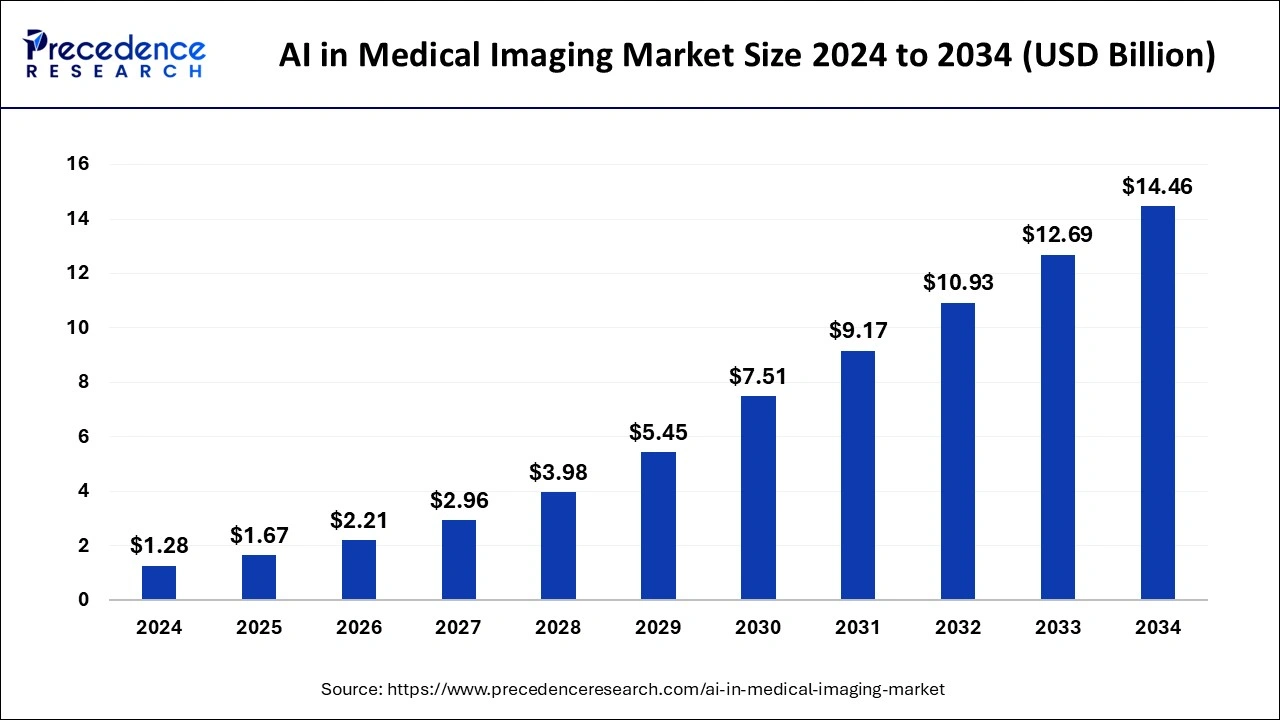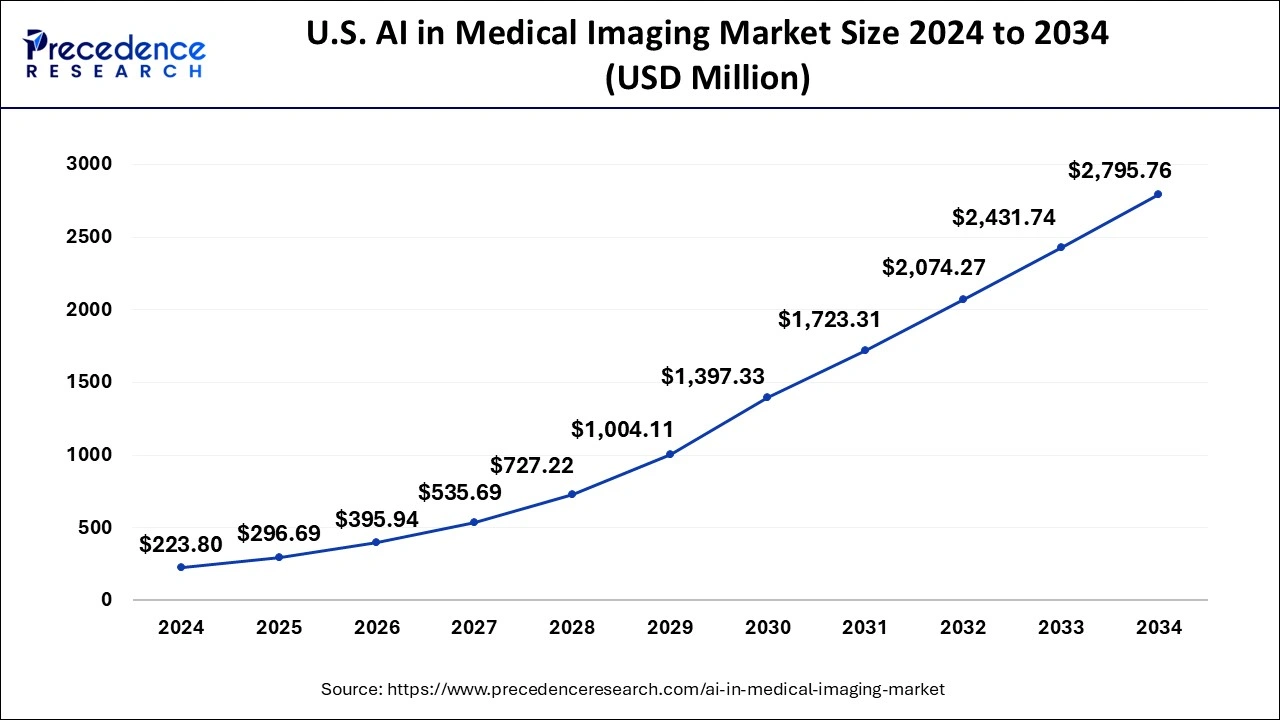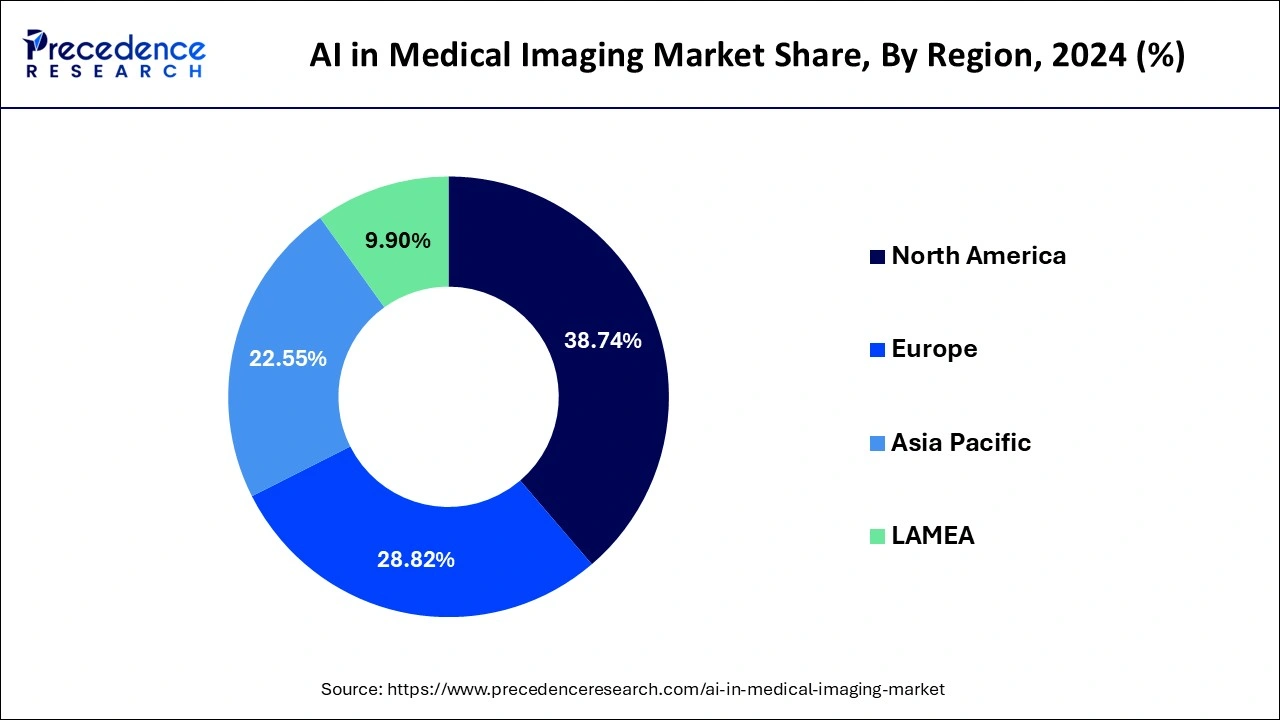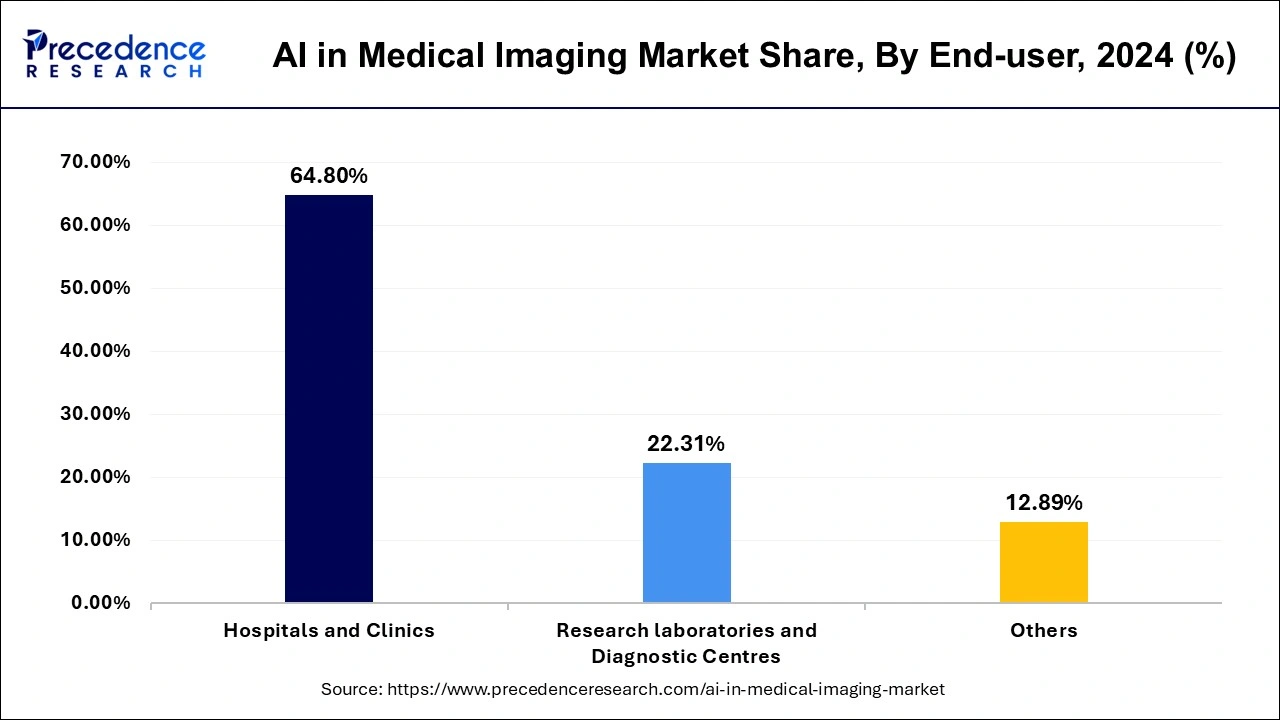December 2024
The global AI in medical imaging market size is calculated at USD 1.67 billion in 2025 and is forecasted to reach around USD 14.46 billion by 2034, accelerating at a CAGR of 27.10% from 2025 to 2034. The North America AI in medical imaging market size surpassed USD 494.27 million in 2024 and is expanding at a CAGR of 27.50% during the forecast period. The market sizing and forecasts are revenue-based (USD Million/Billion), with 2024 as the base year.
The global AI in medical imaging market size was estimated at USD 1.28 billion in 2024 and is predicted to increase from USD 1.67 billion in 2025 to approximately USD 14.46 billion by 2034, expanding at a CAGR of 27.10% from 2025 to 2034. The diagnostic process known as medical imaging may be characterized as the generation of visual aids and picture representations of the human body, as well as the observation of the performance and functionality of the human organs. Artificial intelligence (AI) is changing how diagnoses and the whole procedure are carried out in the healthcare and medical imaging fields.

The U.S. AI in medical imaging market size was valued at USD 223.80 million in 2024 and is expected to reach USD 2,795.76 million by 2034, growing at a CAGR of 28.30% from 2025 to 2034.

Due to their highly developed healthcare systems and high levels of disposable wealth, North America and Europe dominate AI in the medical imaging industry. The need for artificial intelligence in medical imaging has also been spurred by the existence of important players and supportive governmental legislation.
Throughout the projected period, the Asia Pacific is anticipated to increase at a profitable pace. The frequency of illnesses and the growing population might be blamed for the rise. Additionally, the market is growing due to the rapidly modernizing healthcare infrastructure in Asian nations like China, Indonesia, and India.

One of the most promising areas of health and medical innovation is the use of artificial intelligence (AI) in medical imaging. Medical imaging uses AI in a variety of ways, including image capture, processing for assisted reporting, planning for follow-up visits, data storage, data mining, and more. AI has demonstrated impressive sensitivity and precision in the categorization of imaging abnormalities in recent years, and it guarantees to enhance tissue-based detection and characterization. A branch of artificial intelligence called machine learning (ML) uses computational models and algorithms that mimic the structure of the brain's organic neural networks. Layers of linked nodes make up the architecture of neural networks. Each network node weights and summarizes the input data before sending them to the activation function.
The diagnostic process was changed by the use of AI in healthcare and medical imaging, which stimulated the growth of the market for AI in medical imaging on a global scale. Medical practitioners are assisted by artificial intelligence in the execution of the picture acquisition process and in the analysis of these pictures for the diagnosis and personalized care of each patient. AI has been utilized by researchers to objectively evaluate radiographic properties and automatically identify difficult patterns in imaging data. In radiation oncology, Artificial Intelligence has been used to enhance many distinctive image modalities which are used at various stages of the therapy. One of the most well-liked study subjects in medical imaging nowadays is radiation omics, which involves the high-throughput extraction of a significant number of picture attributes from radiation images.
Additionally, AI plays a crucial role in the analysis of a large volume of medical photos, which reveals illness signs that are otherwise missed. As a result, it is anticipated that the market for AI in medical imaging will expand during the next years. Scientists have significantly advanced the effort to combat COVID-19; new study discoveries, such as analytical reports as well as publications from both university and corporate researchers, are emerging every day. A growing number of researchers are turning to artificial intelligence (AI) to detect and forecast diseases in the context of medical imaging studies. AI-based image analysis algorithms offer more accurate, effective, quick, stable, and reproducible illness information than conventional image processing techniques. The basis of AI-based COVID-19 diagnosis processes is therefore image analysis, image segmentation of infected lung regions, and analytics for clinical evaluation. During the anticipated timeframe, these AI-based methods have shown great commercialization potential for AI in the medical imaging sector.
| Report Coverage | Details |
| Market Size in 2024 | USD 1.28 Billion |
| Market Size by 2034 | USD 14.46 Billion |
| Growth Rate from 2025 to 2034 | CAGR of 27.10% |
| Base Year | 2024 |
| Forecast Period | 2025 to 2034 |
| Segments Covered | AI Technology, Solution, Modality, Application, End Use, and Regions |
| Regions Covered | North America, Europe, Asia-Pacific, Latin America, and Middle East & Africa |
AI-based diagnostic imaging improves care models in the healthcare sector
Medical professionals' reluctance to utilize AI-based technology
Emerging economies display significant potential
The x-ray segment held the largest share in AI in medical imaging market. Artificial intelligence (AI) algorithms have the ability to identify minute patterns or abnormalities in X-ray pictures that human radiologists can miss, increasing diagnostic precision and lowering the possibility of a false positive. The time needed for diagnosis can be decreased by using AI to automate the process of X-ray picture analysis. This can be very important in emergency cases where patient outcomes depend on prompt diagnosis. Rather than taking the place of radiologists, AI is a tool to enhance their talents. AI-generated insights can help radiologists make better decisions and treat patients more effectively. Precision medicine is advanced by AI in medical imaging, which goes beyond diagnosis to incorporate predictive analytics, customized treatment planning, and outcome prediction.
The computed tomography segment is expected to be the fastest growing market during the forecast period. Among the major components of the AI in medical imaging market is computed tomography (CT). Artificial intelligence (AI) technologies have improved the efficiency, accuracy, and interpretation of CT scans in the field of medical imaging. AI algorithms can improve CT scan image reconstruction methods, minimizing artifacts and enhancing image quality. Better visuals for diagnosis result from this. Radiologists can use AI to help them identify and describe anomalies, tumors, or lesions on CT scans. It can support early cancer diagnosis and therapy planning, among other things. AI can automate repetitive processes in CT imaging workflows, including data administration, report production, and image processing, which boosts productivity and efficiency in radiology departments.
The hospitals and clinics segment held the largest share in AI in medical imaging market. AI technology is being incorporated by numerous hospitals and healthcare systems into their medical imaging departments in an effort to improve patient care, workflow efficiency, and diagnosis accuracy. Businesses that manufacture medical imaging equipment have begun adding AI features to their products or creating AI-powered alternatives to enhance their selection. A lot of IT businesses are concentrating on creating AI software and algorithms specifically for medical image analysis. A few of these businesses are becoming more well-known in the industry and forming alliances with healthcare providers. To enhance healthcare results and cut costs, government health organizations across the globe are now investing in AI technologies for medical imaging. These organizations might oversee regulations, give funding for research studies, or assist with pilot projects.

The research laboratories and diagnostic centers segment is expected to be the fastest growing market during the forecast period. Google Health has been actively contributing to the AI medical imaging application development process. They have research teams that are focused on applying machine learning algorithms to diagnose diseases and analyze images. Microsoft has made investments in medical imaging and other AI-related technologies. They work together with academic institutions and healthcare organizations to provide AI-driven picture analysis and diagnosis solutions. Another significant participant in the medical imaging market is Siemens Healthineers. To enhance the functionality of their imaging equipment and allow for more precise diagnosis, they have been investing in AI research and development. An increasing number of firms are focused on medical imaging enabled by AI. These firms work closely with academic institutions and healthcare organizations to create and market cutting-edge artificial intelligence technologies.
AI in Medical Imaging Market Revenue (USD Million), By End User, 2022-2024
| End User | 2022 | 2023 | 2024 |
| Hospitals and Clinics | 489.13 | 633.10 | 826.76 |
| Research Laboratories and Diagnostic Centres | 171.18 | 219.75 | 284.61 |
| Others | 102.53 | 129.31 | 164.49 |
The neurology segment held the largest share of AI in medical imaging market. Artificial intelligence (AI) algorithms are capable of analyzing medical images from CT (Computerized Tomography) or MRI (Magnetic Resonance Imaging) scans to identify anomalies in the brain, including tumors, lesions, or indications of neurodegenerative disorders like Parkinson's or Alzheimer's. Accurate segmentation of brain structures and regions of interest in medical pictures is made possible by AI approaches. For tasks like radiation therapy, surgical planning, or monitoring the course of a disease over time, this division is essential. Large datasets have taught AI algorithms to recognize patterns and connections in medical images that might not be immediately obvious to human observers. AI can help doctors with individualized patient care by using these patterns to predict neurological condition risk factors, treatment response, and illness progression.
The breast (Mammography) segment is expected to witness a notable rate of growth during the forecast period. Artificial intelligence (AI) in medical imaging, especially mammography, has great potential to improve breast cancer early detection and improve diagnostic accuracy. Although mammography is an essential technique for screening for breast cancer, it occasionally produces false positive results or misses subtle abnormalities. Deep learning algorithms that have been trained on big data sets of mammogram pictures are commonly used in mammography-specific AI products in the medical imaging market. These algorithms exhibit great sensitivity and specificity in identifying patterns suggestive of breast cancer, such as microcalcifications, masses, or architectural abnormalities. AI workflow integration for mammography has the potential to expedite report turnaround times, simplify interpretation procedures, and enhance patient care in the long run.
AI in Medical Imaging Market Revenue (USD Million), By Application, 2022-2024
| By Application | 2022 | 2023 | 2024 |
| Digital Pathology | 96.04 | 123.27 | 159.64 |
| Oncology | 85.29 | 110.15 | 143.53 |
| Cardiovascular | 82.69 | 106.22 | 137.67 |
| Neurology | 158.98 | 205.79 | 268.76 |
| Lungs (Respiratory System) | 64.23 | 83.12 | 108.51 |
| Breast (Mammography) | 139.37 | 180.94 | 236.99 |
| Liver (GI) | 54.85 | 70.36 | 91.06 |
| Oral Diagnostics | 31.73 | 40.44 | 51.99 |
| Others (Pediatric ailments, Orthopedics, etc.) | 49.66 | 61.88 | 77.70 |
By Solution
By Image Acquisition Technology
By Application
By End Use
By Geography
For inquiries regarding discounts, bulk purchases, or customization requests, please contact us at sales@precedenceresearch.com
No cookie-cutter, only authentic analysis – take the 1st step to become a Precedence Research client
December 2024
October 2024
November 2024
November 2024